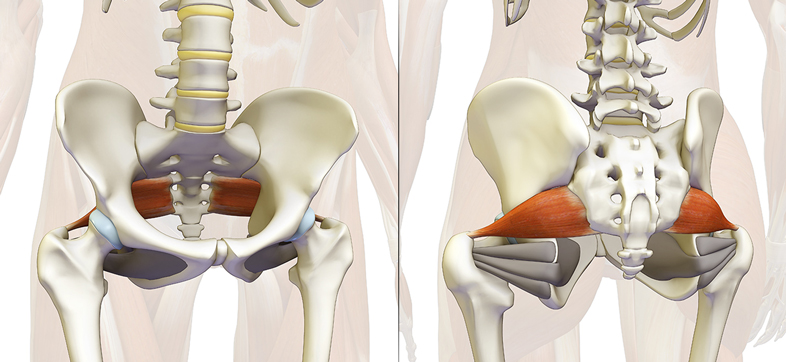The Misunderstood Muscle - The Piriformis
And The Cause of Much Pain and Discomfort
The Piriformis is an external hip rotator — located deep in the butt. Its function is to rotate the hip outward and to stabilize the pelvis, especially during a movement like walking or running, so we don’t wobble.
The Piriformis is one of those muscles that’s rarely understood by a large majority of people including those in the health-care field. For example, most people believe that their Piriformis is too tight and that it needs to be stretched. As a result, there are many recommendations by yoga teachers, personal trainers, and even physical therapists to stretch the Piriformis with such exercises as the Number 4 stretch or the Reverse Pigeon Pose.
But Stretching Doesn’t Help
Figure 2 — Yoga Poses That Stretch The Piriformis
Figure 2 illustrates some variations for this stretch: (a) is the classic stretch that’s typically used in yoga, (b) is a modification for those that can’t do a full stretch, (c) stretches the piriformis of the lower side leg by adducting and internally rotating the femur, (d) adducts (draws toward the midline) the upper side leg, thus opposing the action of the piriformis for abducting the femur, (e) is a variation used in physical therapy as part of the regimen for Piriformis Syndrome, a condition that can cause sciatica.
Usually, these stretches only provide temporary relief, while pain or tension doesn’t get better in the long term. We do not recommend these exercises or stretching this muscle at all because it’s not necessary!
Why stretching is Bad News
What actually happens when the Piriformis feels tight? And does it really get tight?
Yes, it does get tight, but not for the reason most people think.
In Thai Neuromuscular and Thai Therapeutic sessions, we use a technique called “Pin and Stretch.” This is when we pin or compress a certain muscle, and stretch it at the same time. This achieves a lengthening of the muscle fibers and a greater range of motion in the related joints. An example of “Pin and Stretch” is the Pectoralis muscle stretch. We pin or compress the Pec against the ribcage, and move the arm away at different angles. After the technique the shoulder ‘enjoys’ greater mobility and a rush of energy through the Pecs.
“Pin and Stretch” is also what we do to our Piriformis when we sit down. We pin it to the seat and then stretch it when we cross our legs, which many people do.
This means that your Piriformis is being stretched all the time. In fact, in most people, the Piriformis is overstretched. What happens to a muscle that has been overstretched? Two things.
1. It becomes weak and loses its ability to perform its function (in Piriformis, it’s to stabilize the pelvis)
2. It goes into a state of spasm (contraction)
The first one is clear. Overstretched and weak muscles do not work very well. But how does a weak overstretched muscle go into a spasm?
Neural Inhibition
When a muscle becomes stretched to its maximum length and held in that position for a long time (longer than a minute), it sends a signal to the brain: “Help! Release the stretch! I need to return to neutral to avoid tearing.”
But it doesn’t return to neutral (because we continue to stretch it). So the brain forces it to contract, also known as a spasm or a cramp – a forced contraction to prevent tissue damage.
And what do people do when we feel a spasm or a cramp?
Well, we stretch it even more, of course. We are told to stretch it. We believe it will relieve the spasm, as occasionally dynamic stretching does. But usually we hold deep Piriformis stretches, and cause tiny tears in the cramped muscle. Now it’s cramped, slightly torn, AND weak!
When we sleep, the body (due to its innate intelligence) repairs the tiny tears. It lays a patch of collagen fibers.What happens when we wake up?
We feel the repair work – the Piriformis “feels” tight, because the body patched it up a little bit.
Here is the clincher:
We mistake the sensation of healing, or patching up, aka tightening, for tension. We say: “My Piriformis feels so tight. I keep stretching it and stretching it.”
So we go ahead and hold those deep stretches yet again. Of course, we rip apart all that patchwork/repair work. We believe this kind of stretching “feels” like a good kind of pain – it feels like we are really pulling it apart, ripping it, because that is exactly what is happening.
The next night the healing process repeats itself. And the next morning, we “feel” tight again, and so we stretch. And so on.
This can go on for months, never getting better. Slowly getting worse. Constant ache and inflammation develops. The cramping muscle may press over the Sciatic nerve causing painful sensation in the butt and down the leg. Eventually, those microscopic tears become full blown adhesions that we, the massage therapists, are able to feel with our fingers.
So what to do?
Well, for starters, stop stretching your poor Piriformis. Very few of us ever need to stretch that muscle.
Strengthening the Piriformis will start the healing process. In essence, it would support the body’s efforts to repair it and tighten it back so it can function again.
Key point — LET IT GET TIGHT!
At first, tightness means that healing bonds are forming. Don’t rip them apart! Once the muscles get stronger, they will stop “feeling tight.” They will relax and actually feel longer and healthier.
Front/Rear View of Piriformis
We are taught that tension is bad and flexibility is good. In reality, that is just not the case. Tension is good – in most cases, tension means strength and stability and efficient function. Too much flexibility means possible instability, weakness, and loss of efficiency in movement.
At Thaisport Bodyworks, our Neuromuscular experts can determine the health of your Piriformis. We can relieve a cramped Piriformis by doing a Piriformis Release technique that’s part of our Thaisport Neuromuscular Protocol, and finally initiate the healing process!
Slava Kolpakov


